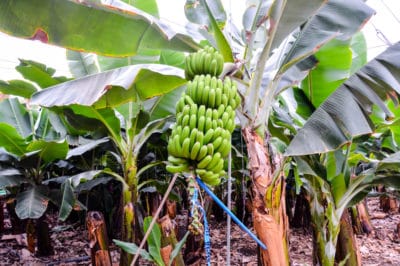Where Bananas Grow
Most bananas are tropical plants. If you live in tropical areas or USDA Zones 9 through 11, you have a good shot at growing them outdoors. A few varieties are hardy to Zone 4. Those are not the typical grocery store banana – which is usually a Cavendish – but varieties known as plantains. Plantains are cooked rather than eaten fresh and many are reddish rather than yellow.
Choosing Banana Varieties
Musa acuminata and Musa balbisiana are the wild varieties from which nearly all available hybrids are derived. Most are grown as ornamentals. You may find these varieties:
- Ensete glaucum: Snow Banana, Elephant Hip Banana
- Musa basjoo: Basjoo banana tree
- Musa ornata, Purple Flower Form, Bronze Banana
- Musa textilis: Abacá Banana
- Musa velutina: Pink Velvet Banana
- Musa ‘Bordelon’: Bordelon Red Banana Tree
Soil for Bananas
The banana is a heavy feeder. Its lush, large leaves and single flower stem need plenty of the basic nutrients like nitrogen, potassium and phosphorus. The soil in which you grow bananas should be rich, with lots of humus from aged leaf mold, organic compost and well-rotted manure. However, it must also drain well, so fine gravel, crushed lava rock or perlite is also required.
Watering Bananas
The product of tropical rain forests, bananas thrive with regular watering and high humidity. However, standing water and soggy soil will quickly induce root rot. Depending on your climate, the weather and the plant’s location, you will probably need to water every two or three days during the growing period. Soil should be evenly moist. In winter, much less water is needed.
Fertilizer for Bananas
Bananas have high nitrogen and potassium requirements, but need much less phosphorus, as well as much smaller amounts of micro-nutrients like calcium, magnesium and zinc. Commercial growers typically use fertilizer with an NPK ratio of 13-10-30. However, these growers also hold phosphorus in the summer and decrease nitrogen in fall. Weekly dilute feedings are usually recommended.
Locating Bananas
Bananas are an understory plant. While they do need plenty of light, it should be indirect bright light rather than full sun, especially in the hottest part of the day. Dappled shade in the late afternoon is good for bananas grown outdoors. Inside, a bright sunny window with translucent blinds or shades to protect from direct sun is the best choice.
